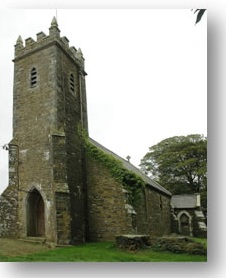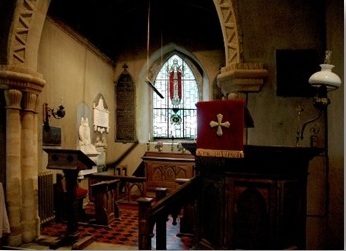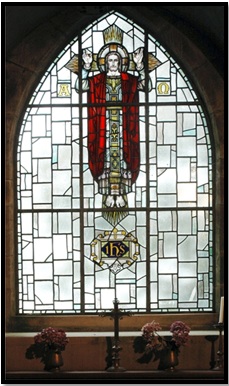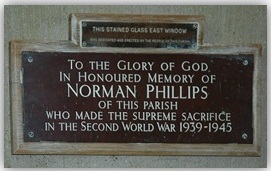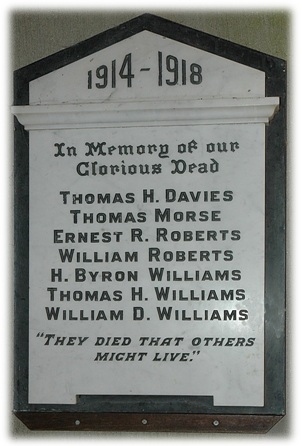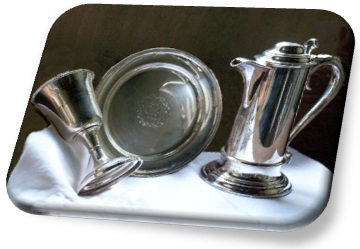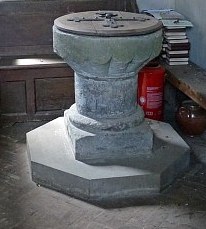The settlement at Jordanston lies on the ridge of land that separates the valley of two streams, the Cleddau Wen and the upper reaches of the Western Cleddau. The recent discovery of a pair of standing stones at the entrance to the field next to the church car park is evidence that it was a site of some significance even in prehistoric times. The stones appear to be a dolerite of the type known as ‘Preseli bluestone’, pipes of which also occurs in the Fishguard volcanic suite on Pencaer and Strumble head. From the way that they have been shaped and dressed, it is likely that they may date from Neolithic times, around 3000 BC.
A number of tumuli or burial chambers have been identified in the area in a field at the Jordanston crossroads and a Bronze Age axe was found at Tredafydd, a nearby farm. Settlement density was on the increase in later prehistoric times and there are a number of Iron Age farm enclosures in the vicinity. The nearest is Castell Hendre Wen beside the road between the Jordanston crossroads and the A487.
From the 5th century onwards, Christian symbols and inscriptions came to be used on stones for personal memorials and markers. One such inscribed stone of the 5th or early 6th century is still to be seen in the private grounds of Llangwarren house. This is a personal memorial, inscribed in Latin and Ogham, to TIGERNACI DOBAGNI. There is some doubt as to whether this represents one or two people, possibly father and son as the Ogham consists only of the personal name Dobagni. Since the name of the house includes the prefix ‘llan’, it is possible that the site also had early Christian associations. There is also evidence for Irish connections in the use of the Ogham script, an association that is characteristic of some of the early Christian stones of north Pembrokeshire.
St. Cwrda’s Church
Set into this rich historical landscape lies the quaint little church of Jordanston. Though small in size, it is rich in historical associations and it has a remarkable number of connections with a host of interesting characters.
The Name
In 1291, it is recorded as ‘’Ecclesia de Villa Jordahi’ (which is probably a misreading of ‘Jordani’ ). In 1324, in the Inq. post mortem of Aymer de Valence, Earl of Pembroke, it is described as ‘Jurdanestoun’. In 1543, listing monies collected for the defence of Christendom against the Turk, 5d was collected in ‘Jordenston’, whilst in 1786 it is described as the rectory of ‘Jordanston alias Tre Jordan’.
Dedication
The modern dedication is to St. Cwrda, a saint who has largely North Wales connections. The only other West Wales dedication to him is at Llanwrda in Carmarthenshire. Some, however, doubt whether the dedication to the Celtic saint is genuine, arguing that there is no reason for this ascription other than the fact that the Welsh name for the parish is Trefwrdan, which is a literal translation of the name Jordanston. Some authorities ascribe the dedication to St. Mary.
History
There is a school of thought which is of the opinion that the secular medieval lords of Jordanston founded the church, but Jordanstan makes its first definite appearance in the pages of history in the 1291 ‘Taxatio’ when it was assessed at £6 13s 4d for tenths to the king, the amount payable being £2 13s 4d. In 1411, John Adams, vicar of Marloes agreed to exchange his living with John Howell, rector of Jordanston. By 1536, the annual value was £6 3s 7d , in tenths 12s 4.5d. Of the medieval structure referred to in 1291, probably nothing survives, except for the font, as the building has been repaired and restored on several occasions. A major rebuilding took place in 1797 and no earlier fabric was retained. The late eighteenth century architect is unknown, but the church built was described by Lewis in 1833 as a ‘small, neat edifice’’ but ‘not distinguished by any interesting details.’ The event is commemorated on a small plaque which can be seen behind the pulpit.
There was another major restoration in 1863, when the tower was also built. The tower was restored in 1880 and a transeptal vestry added in 1883. 1910 saw another restoration, but this work was apparently largely superficial.
LOCAL FAMILIES
It becomes immediately apparent from the numerous plaques to be found within the church, that Jordanston is very much a gentry church.
The Vaughan Family of Jordanston Hall
The Vaughan family originated in Radnorshire. Their connection with Jordanston commenced when John Vaughan married the Gwynn heiress, Matilda, in the mid seventeenth century, thereby inheriting the Jordanston estate which had held by the Gwynn's since the mid sixteenth century. The Vaughans remained at Jordanston for almost two hundred years until the last of the family, Gwynn Gill Vaughan, bequeathed the estate to his friend, Sir James Cockburn. Sir James’daughter, Marianna Augusta, married Col. Sir James John Hamilton.
The Mathias Family of Llangwarren
The Mathias family originated in Nevern and their links with Jordanston parish began when Thomas Mathias (d.1617) married co-heiress Jane Lloyd who received Llangwarren as her portion of the estate of the Lloyd family of Llanstinan. A number of the family had very distinguished military careers. Llangwarren remained the focus of the Mathias family until 1820 when they purchased lands in South Pembrokeshire and built Lamphey Court. However, a branch of the family returned to their ancestral seat in the 1880’s and they remained there until 1987 when the house was sold although they still retain an interest in the parish.
The Lloyd George Connection
The George family originated in North Pembrokeshire. By the Nineteenth Century, the immediate antecedents of David Lloyd George, the World War One Premier, were settled at Trecoed in Jordanston parish and a number of his close family are buried in the churchyard. Though the Prime Minister was born in Manchester, his family retained a close link with the county. David Lloyd George’s brother, William, married a cousin in Fishguard, whilst the Prime Minister’s son, Major Gwilym Lloyd George was the county M.P. for many years, eventually becoming Viscount Tenby. The third Earl Lloyd George of Dwyfor resided for a number of years at Ffynnone in North Pembrokeshire.
TOUR OF THE CHURCH
Below is a plan of St Cwrda's Church, Jordanston
showing the locations of the numbered points of interest
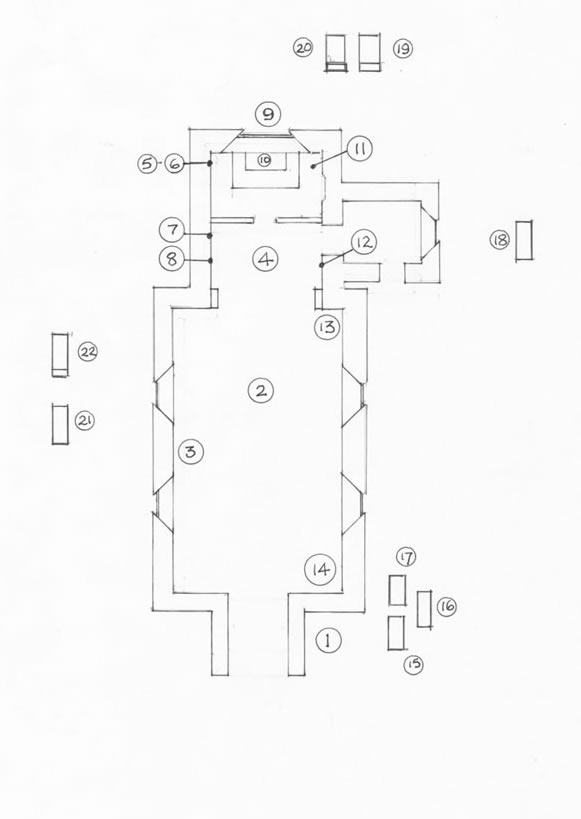
The Tower ~ (Point 1)
The Church is entered through the angle buttressed west tower which was built by Sir James John Hamilton and his wife, Marianna Augusta, Lady Hamilton in 1863 The Hamilton coat of arms erected on the west wall of the nave marks the event. Of two storeys, the church entrance occupies the ground floor and there is a plain two-centred arch. A belfry occupies the second floor and the tower is surmounted by pinnacles and battlements, all with oolite dressings. The tower was restored in 1880.
The Nave ~ (Point 2)
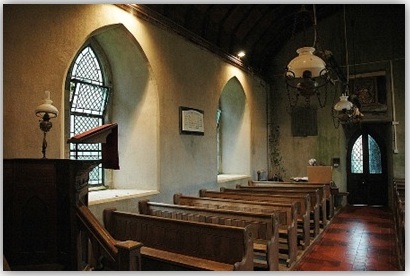
The three-bayed nave dates from the 1797 restoration. All dressings date from the 1863 renovation and are of oolite in a neo-gothic style. On the west wall of the nave will be found the Hamilton plaque commemorating the work carried out at the church in 1863, including the building of the tower.
The coat of arms are those of Col. Sir James John Hamilton, Bart, who had married Marianna Augusta, the daughter of Sir James Cockburn who was bequeathed the Jordanston estate from the last of the Vaughans.
Flanking the central plaque will be seen the tablets inscribed with the Ten Commandments and these compliment the two on the east wall of the chancel with contain the Lord's Prayer and Apostle's Creed.
THE PEEL MEMORIAL ~ (Point 3)
The Elizabeth Peel commemorated on the plaque on the north wall of the nave was the daughter of John Entwistle of Foxholes, Leics. She married Robert Peel, the eldest son of Lawrence Peel of Ardwick, Lancs. Lawrence was the younger brother of Sir Robert Peel, Bart. the father of the nineteenth century founder of the modern police force and Prime Minister, Sir Robert Peel. The son of Robert and Elizabeth Peel, John Entwistle Peel owned Stone Hall, St. Lawrence at one time.
THE CHANCEL ~ (Point 4)
The two-bayed chancel, with 1863 fittings, is entered through a Bath stone arch. The decoration possibly attempts to create the kind of capital used in early church/temple architecture in Egypt and is probably due to the influence of Marianna, Lady Hamilton who was a student of architectural form. She may have thought, in this instance, that a simple shape might be suitable for a country church. The earliest known rector was John Howell who can be dated in office to 1403 as in that year he was appointed dean of Roos and Dungleddy. Presentation to the living always belonged to the owners of the manor. When Thomas John was appointed in 1487 by Master William Sommer, an Episcopal Commission was issued to inquire into the right of presentation be exercised by William Sommer. In the Sixteenth Century, the right of presentation belonged to the Wogan family of Boulston: Richard exercised the right in 1535, and John in 1563. In George Owen’s lists of manors in 1594, we learn that the patron of the rectory was Sir John Wogan of Boulston. In 1625 Jenkin Gwynn appointed Rice Evans as rector and from 1674 the right of presentation was in the hands of the Vaughan family.
THE EAST WINDOW ~ (Point 9)
The only stained glass in the church is the east window and it depicts the Crucifixion, with Chirst portrayed in red. Designed by Celtic Studios, Swansea, it was installed in 1949 as a memorial to parishioner Norman Phillips who made the supreme sacrifice during the Second World War.
The above shown memorial is to the Fallen of the First World War.
Originally recording ex-pupils of Manorowen school, it was moved from there to the church in 2004, when the County Council closed what was by then called Tredafydd school
THE COMMUNION TABLE ~ (Point 10)
The Communion vessels of Jordanston consist of a plated Chalice, Paten and Flagon. All three pieces are decorated with the sacred monogram within a crown of thorns and they bear the following inscription: 'Jordanston Church. Presented by Sir James John and Lady Hamilton 1863'
THE RESTORATION PLAQUE ~ (Point 13)
Above the pulpit can be seen the plaque placed to mark the restoration of the church in 1797. Gwyn Vaughan was the churchwarden and Thomas Gibbon his deputy.
THE FONT ~ (Point 14)
Most authorities agree that the font is Norman and is a survivor from the medieval church. It has a circular head of 24 inches diameter, that of the basin 19 inches,
and is chamfered to a circular shaft and square base. Its total height is 27 inches. Christening and Burial records in Jordanston date back to 1802 and Marriage records to 1803. Bishop Transcripts commence in 1799, but the list is not complete.
RECTORS OF JORDANSTON FROM 1403 TO PRESENT TIME
1403 |
John Howell |
1487 |
Thomas John |
1535 |
Dr Bach |
1554 |
Rees ap Owen |
1563 |
John Gwynne |
1625 |
Rice Evans |
1674 |
Richard Owens |
1680 |
David Jones |
1692 |
John Edwards |
1699 |
William Evans |
1713 |
George Jones |
1714 |
John Herneman B A |
1720 |
William Jones B A |
1734 |
James Griffiths |
1748 |
David Jones |
1766 |
Edward Phillips B A |
1772 |
Thomas Morris |
1801 |
Thomas Thomas |
1813 |
David Evans M A |
1828 |
John Bowen |
1848 |
Henry Nathan |
1885 |
Joseph Evans |
1923 |
R E Davies |
1926 |
W.C.L. Davies |
1935 |
James Lloyd |
1943 |
W E Davies |
1950 |
J Williams - Priest in Charge |
1952 |
C W B Jones |
196? |
H B Pearce |
1974 |
W G R Lewis |
1978 |
W Glyndwr Jones B A |
1986 |
Geoffrey Asson M A |
1997 |
Paul Lloyd Davies LLB |
2008 |
Alan Salmon - Priest in Charge |
2013 |
Don MacGregor |
.

